The desert is a unique environment characterized by barren land and an air of mystery. It can be home to some of the most unusual creatures that have adapted to survive in extreme conditions with little water or food. This article will look at nine animals that live in the desert and are particularly suited for this harsh landscape.
How Do Animals Adapt To The Desert
Animals have evolved various strategies to survive and thrive in harsh desert environments. These adaptations, which range from physiological changes to behavioral traits, make it possible for numerous species to reside in arid regions worldwide.
The first adaptation that allows animals to live in deserts is a reduction in water loss through decreased body surface area relative to their size. Many desert dwellers, such as lizards and snakes, are small, so they can reduce heat loss; some even curl up into a ball shape when not active. Additionally, many animals lower evaporation by secreting waxy substances on their skin or fur that act as waterproof barriers. Other species possess specialized organs like camels’ humps for storing fat which helps conserve energy during long periods without food or water.
Many creatures also modify their behavior to cope with the hot climate of the desert. Nocturnal animals sleep during the day and come out at night when temperatures cool down. Burrowing mammals dig into the sand where underground temperatures remain stable throughout the year, while others seek shelter under rocks and bushes during scorching days. Some birds travel southward during winter when food sources become scarce due to lack of rain, whereas certain insects migrate seasonally between areas with different moisture levels.
In summary, organisms living in dry areas rely heavily on biological adaptations that allow them to tolerate extreme conditions while still meeting basic needs such as staying hydrated, finding shelter, and obtaining nutrition. Behavioral modifications further enhance these creatures’ ability to survive in this hostile environment while maintaining a sustainable population despite its unforgiving nature by decreasing the size of their range and limiting their contact with other species.
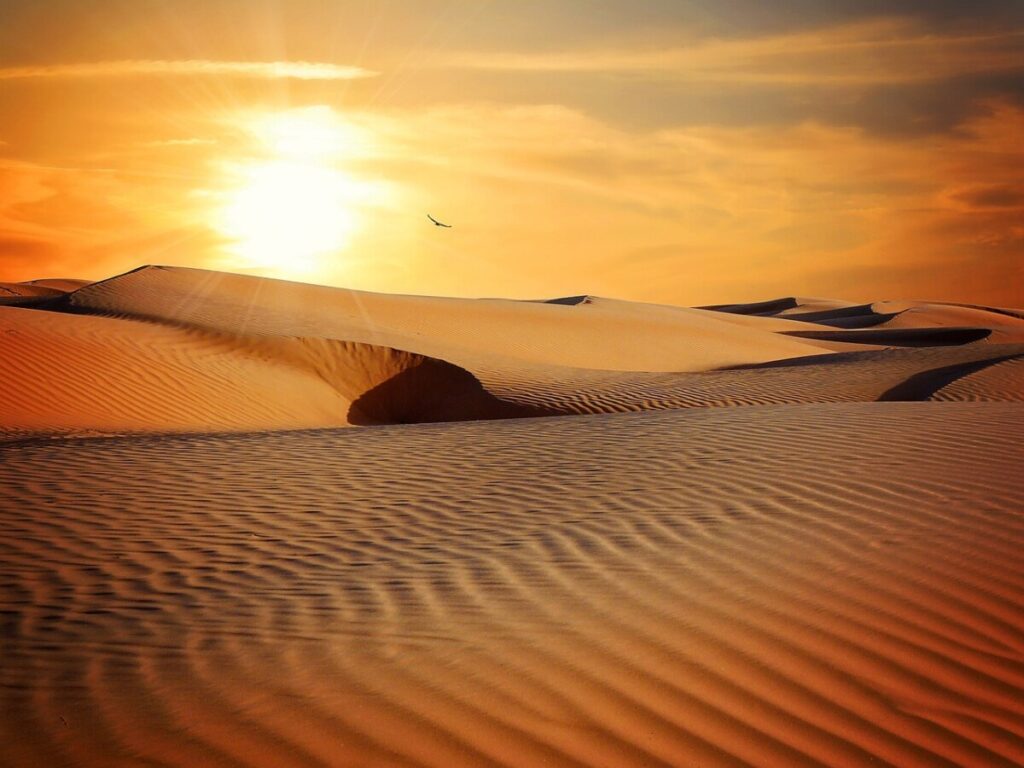
Why Can’t All Animals Live In The Desert
The desert environment is a challenging one for animals to inhabit, and not all species can survive in it. Species that thrive there have certain adaptations which enable them to overcome extreme temperatures and lack of water. This begs the question: why can’t all animals live in the desert? The answer lies both in their physical makeup as well as their behavior.
Physically, some animals possess traits that help them cope with life in the arid landscape, while others do not. For example, many mammals found in deserts are adapted to conserve water; they may have thick fur coats or long bushy tails that reduce heat loss from their bodies, allowing them to remain cool. Some birds will also huddle together at night when temperatures drop drastically.
In contrast, other animal species cannot adapt to such conditions due to physiological limitations – reptiles especially require moist habitats. Hence, they cannot survive extended periods without access to water sources. Additionally, behavioral factors come into play: most large-scale migratory species only visit deserts during specific times of the year when food resources are abundant; otherwise, they might be unable to find enough sustenance regularly if they remained year-round residents of the area.
In summary, there are various reasons why not every animal can live in the desert climate. These include biological features that make some creatures more suited than others for this hostile terrain, as well as behavioral tendencies which dictate how often these animals migrate through or take up residence within an arid region. As our understanding of these different elements grows deeper over time, we may gain insights into further improving conservation efforts geared towards protecting species living in deserts worldwide.
How Many Animals Live In The Desert?
A desert environment is difficult for many species to thrive due to its extreme temperatures and limited water and food sources. Consequently, it is important to understand how many animals live in the desert biome. The answer depends on which particular region one examines. According to research conducted by biologists from the University of California – Merced, there are around 5,000 different animal species living in deserts worldwide.
In North America alone, approximately 1,500 species inhabit various ecosystems. These include mammals such as coyotes and jackrabbits; reptiles like rattlesnakes and lizards; birds including roadrunners and quail; amphibians such as spadefoot toads; insects like grasshoppers and beetles; spiders like tarantulas; arachnids like scorpions; crustaceans such as kangaroo rats; small rodents like mice and voles; fish such as catfish; snakes including sidewinders and garter snakes; bats including pallid bats and big-eared bats; small marsupials like opossums; millipedes including giant desert centipedes; ticks including brown dog ticks: and numerous other creatures.
Each species has adapted itself according to the conditions of its habitat to survive in an otherwise harsh climate. While some animals have evolved special features that allow them to conserve energy or collect moisture during dry seasons, others may migrate elsewhere when resources become scarce – allowing them access to food supplies not available locally. Despite these adaptations, however, only a fraction of all known animal species can be found living in deserts across the globe.
Where Do Animals Live In The Desert?
The desert is a unique biome with many different species of animals living in it. Different types of animals can survive in the harsh conditions of the desert, including mammals, reptiles, and insects. It is important to understand where these animals live to better protect them from human encroachment or other threats. In this article, we will explore where animals reside within the desert.
When considering animal habitats within the desert, one must consider several factors, including the type of terrain, availability of food sources, and access to water. Many animals prefer flat areas such as dunes for nesting and protection from predators.
Others may inhabit rocky outcrops providing shelter during extreme weather events or exposure to sunlight during cold nights. Plants are an essential source of sustenance for all creatures that populate deserts; therefore, vegetation plays an important role in determining which environment best suits certain species. Additionally, some species rely on nearby rivers or oases to find water. In contrast, others have adapted their physiology to retain moisture through thick fur coats or long snouts, allowing them to drink directly from shallow puddles.
Understanding what each creature needs to thrive is integral to preserving wildlife diversity across arid regions worldwide. Learning about the various environments needed by specific species native to the desert biome allows us to appreciate this unique ecosystem and work towards protecting its inhabitants against human-induced harm and climate change effects for generations to come.
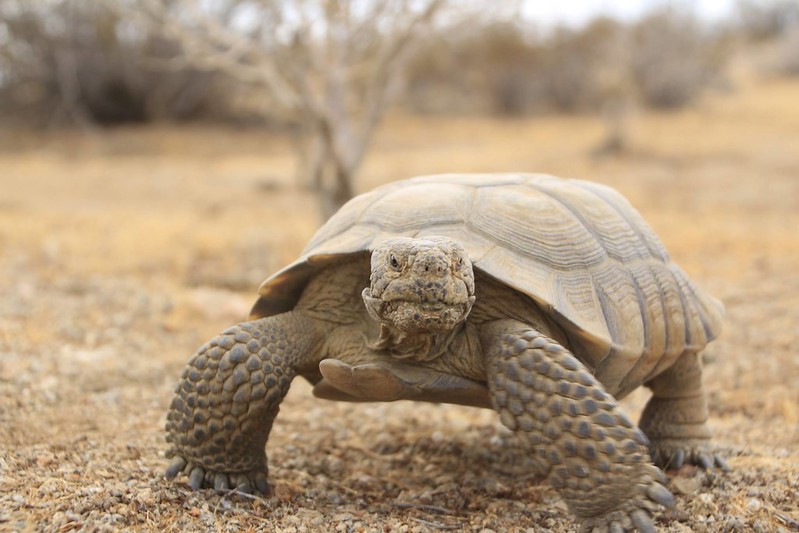
Mojave Desert Tortoise
The Mojave desert tortoise is a species of land turtle that lives in the arid areas of the southwestern United States and northwest Mexico. It is one of the top ten animals in the desert, as it can survive in harsh conditions due to its adaptations. This includes digging deep burrows into sandy soils where they can remain cool during hot days and warm at night.
Mojave desert tortoises are nocturnal and primarily herbivorous, feeding on grasses, cactus pads, flowers, legumes, and other vegetation found around their habitat. They have powerful claws which enable them to dig burrows up to three feet deep for protection from extreme temperatures and predators. Furthermore, they also possess an enlarged upper shell called a carapace which acts as armor against potential enemies such as coyotes or foxes.
This animal has experienced population declines in recent years due to factors such as agricultural development, predation by non-native animals, climate change, and human activities, including off-road vehicle use near their habitats.
In response to this situation, various conservation efforts have been put into place, such as reintroducing captive-bred specimens back into wild populations and creating protected zones within their range. These measures are necessary if we want to ensure the survival of this species in future generations.
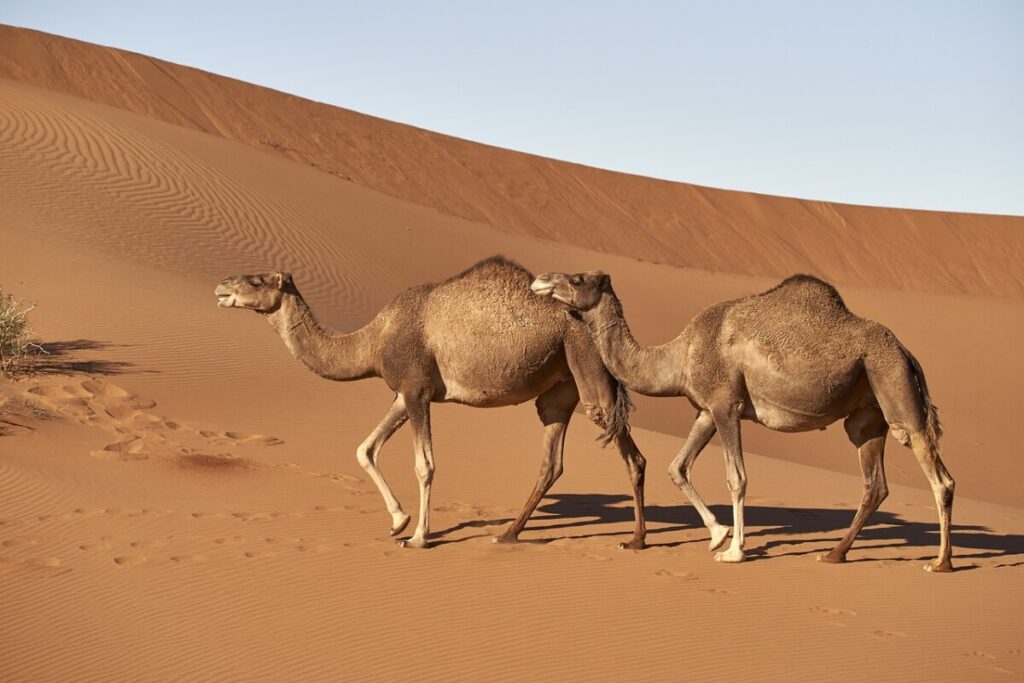
Dromedary Camel
The dromedary camel (Camelus dromedarius) is one of the most iconic species which inhabit desert regions. Its scientific name, Camelus dromedarius, is derived from the Greek language and means “running or hurrying camel”.
The habitat range of this mammal extends across much of North Africa, parts of the Middle East, Central Asia, and India. It has been used for centuries as a transport animal by nomads in these areas due to its ability to carry large loads over long distances with little food or water intake.
This species exhibits an array of adaptations that enable it to survive in extremely arid conditions. Physically, they have evolved along with their environment to develop wide feet that help spread weight evenly on sandy soils and prevent them from sinking into soft surfaces.
Additionally, their ears are small and hairy, preventing heat loss through evaporation while keeping sand out; furthermore, humps store fat reserves, enabling the animals to endure long periods without sustenance. Behaviourally they can alter activity periods depending upon temperature changes; during hot days, they rest in cooler areas such as burrows dug beneath vegetation and come out at night when temperatures drop.
Due to all these advantageous traits, the dromedary camels are well adapted to living in deserts where other mammalian lifeforms may struggle under harsh environmental conditions. In some cases, they form an integral part of communities that rely heavily on them for trade activities between cities and villages far away. Furthermore, they serve many other purposes ranging from providing milk products to being ridden by tour guides in popular tourist attractions like Egypt’s pyramids or Morocco’s Sahara Deserts.
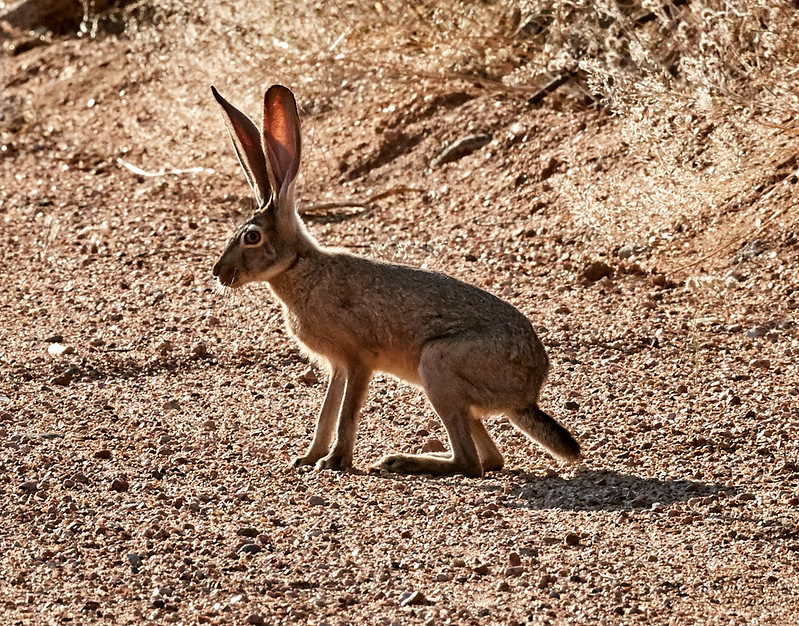
Antelope Jackrabbit
Antelope jackrabbits are some of the most common and well-known animals in the desert. They can be found in various habitats, including hot deserts, semiarid areas, grasslands, savannahs, scrublands, steppes, and mountains. These large hares have long ears that give them an alert appearance; their coloring varies from white to tan or gray depending on the season.
Adaptations such as longer legs enable antelope jackrabbits to run quickly across dunes while avoiding predators. Additionally, they possess special adaptations allowing them to withstand extreme temperatures; these include thick fur, which helps regulate body temperature, and wide eyes, which increase vision capacity during bright daylight hours. Their diet consists mainly of plants like cacti and other succulents but also includes insects when available.
The breeding season for antelope jackrabbits occurs twice each year between January and June, with multiple litters produced per cycle. Females typically produce up to four offspring at once after a gestation period lasting one month, reaching maturity within two months following birth. By five months old, antelope jackrabbits can breed themselves, adding additional individuals into existing populations throughout the desert regions where they live.
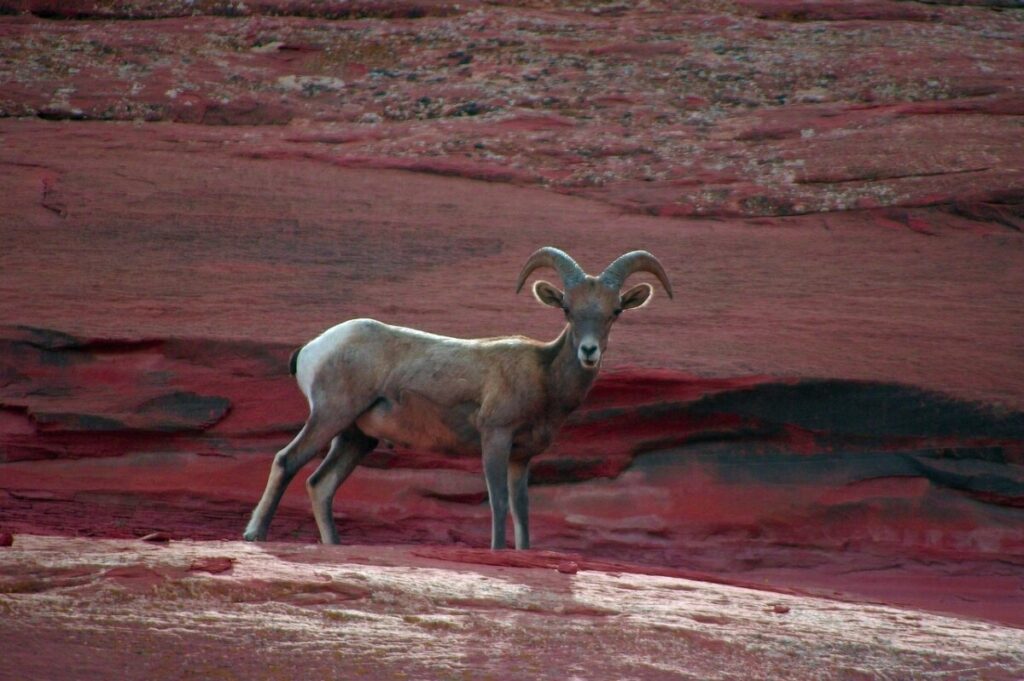
Desert Bighorn Sheep
The Desert bighorn sheep is a wild sheep found in arid and semi-arid regions. They inhabit the arid deserts of western North America, from British Columbia south through California and west to Utah. The animals have long curled horns growing up to three feet (1 meter). They typically weigh between 120 and 200 pounds (54 – 91 kg).
Regarding behavior, desert bighorn sheep are gregarious creatures with strong social bonds within their herds. Groups of males will often form bachelor bands, while female groups contain adults and juveniles. These animals travel together for protection against predators such as coyotes or mountain lions. During mating season, they separate into smaller groups that consist mainly of rams, who engage in physical combat to determine dominance hierarchy before competing for access to ewes.
The diet of desert bighorn consists primarily of grasses, leaves, herbs, and other vegetation depending on seasonal availability. In addition to plants, these animals occasionally eat insects when available. As water sources become scarce during periods of extended drought or high temperatures, the desert bighorns rely more heavily on succulent plants that contain higher moisture concentrations than the surrounding vegetation.
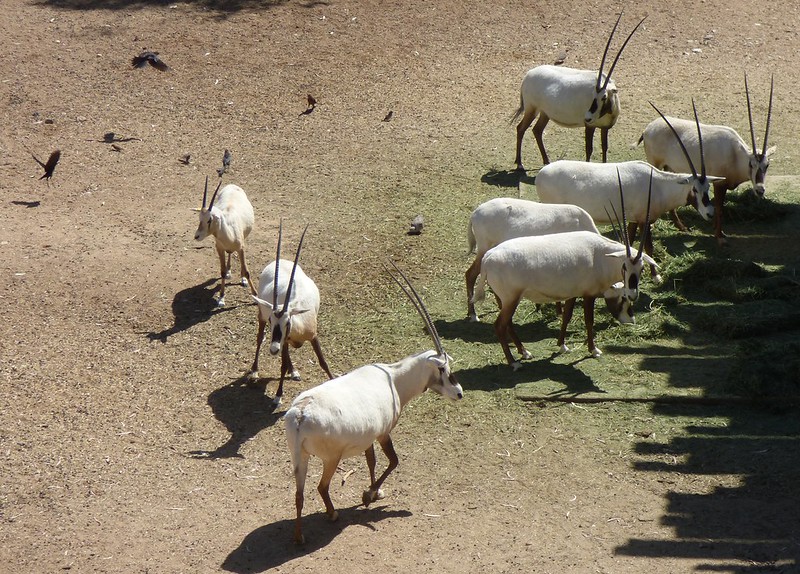
Arabian Oryx
The Arabian oryx, also known as the white oryx, is a large antelope native to desert and steppe areas in the Middle East. It stands approximately 3 feet tall at the shoulder, with males weighing up to 250 pounds and females about 140 pounds. The horns of both sexes are long and curved backward towards their body, with an average length of 35-45 inches. This species was once widespread across North Africa and Southwest Asia, but due to overhunting, it became extinct in the wild by 1972.
In 1977, conservation efforts began by introducing captive breeding programs for the Arabian oryx in Oman, Saudi Arabia, Jordan, and Israel. As a result, there have been numerous successful reintroductions into several national parks, including those in Morocco, Tunisia, and Syria. This species can live in protected areas throughout its former range, where it is classified as “Vulnerable” on the IUCN Red List of Threatened Species due to threats from illegal hunting and habitat fragmentation.
The diet of the Arabian oryx consists mainly of grasses along with other vegetation, such as shrubs and trees, depending on availability within its environment. They usually graze alone but occasionally form small groups during harsh conditions when food resources become scarce.
Breeding takes place year-round but peaks between February-March when temperatures start increasing; newborn calves stay hidden for 2 weeks before joining larger herds consisting of up to ten individuals, which often include one dominant male that defends his harem against other males who attempt to mate with his females.
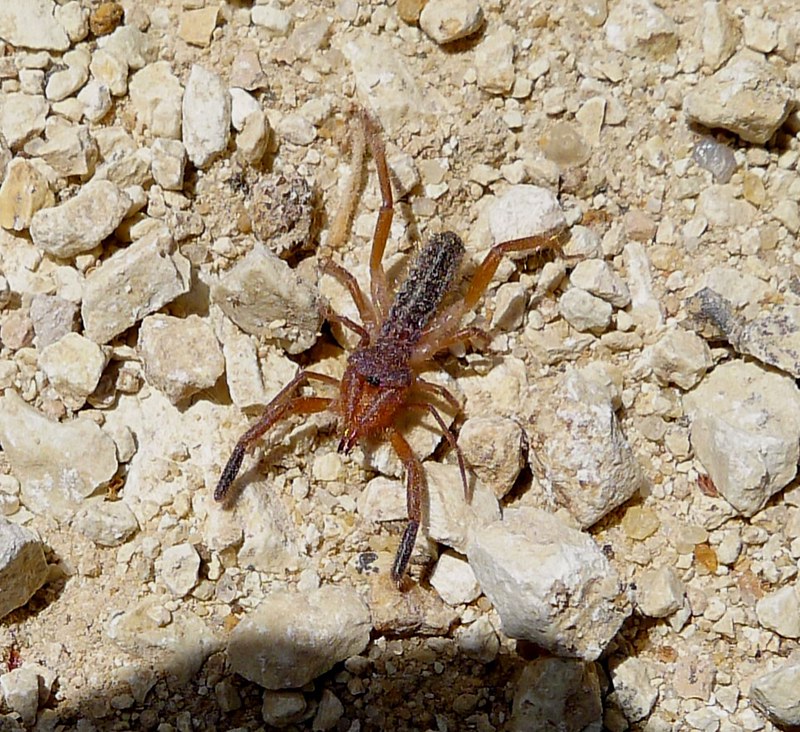
Camel Spiders
Camel spiders, also known as wind scorpions or sun spiders, are arachnids found in the deserts of North Africa and the Middle East. They have a flattened body shape with eight legs and two anterior appendages that serve as sensory organs. Their color ranges from yellowish to reddish brown, and they can grow up to 6 cm long.
These creatures feed on insects and small invertebrates such as lizards and rodents. Camel spiders use their powerful chelicerae to capture prey, then inject venom through hollow fangs into their victim before sucking out the liquefied contents of their body cavity. During mating season, male camel spiders produce vibrations that attract females for copulation purposes.
Due to their fast movements, many people think these animals run at speeds of up to 25 mph; however, this is an exaggeration since most specimens only move at about 10 mph when chased by predators or humans. Despite being harmless to humans, some individuals find them intimidating due to their large size and appearance, which resemble scorpions without tails.
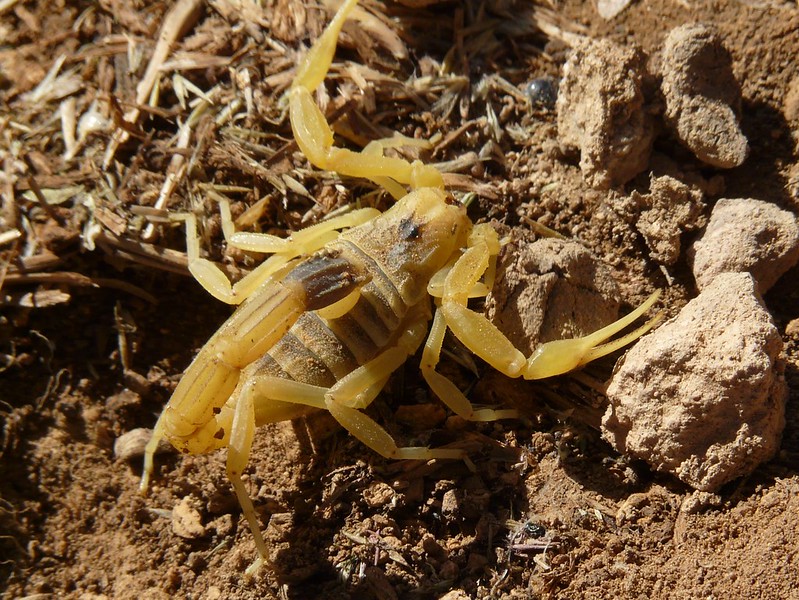
Deathstalker Scorpion
The deathstalker scorpion is a species of arachnid found in the deserts of North Africa, the Middle East, and some parts of India. It has a distinctive yellow-orange coloration that makes it easily recognizable amongst its peers. This highly venomous creature can be dangerous to humans with symptoms ranging from intense pain to paralysis or even death, depending on the amount envenomed.
Due to their toxic nature, these creatures are often hunted for their venom, occasionally used by local tribes as part of traditional medicinal practices. The diet of this species consists mainly of other invertebrates like insects, spiders, centipedes, and even smaller lizards. They possess two pincers at the front end, known as chelae, along with a tail curved over their back called telson; both have evolved as defensive mechanisms against potential predators such as birds, reptiles, and mammals.
Deathstalker scorpions are considered one of the most dangerous animals due to the potency of their venom, but they usually avoid conflict if given an opportunity. As long as people keep a safe distance and exercise proper caution when encountering them, there should be no cause for concern.
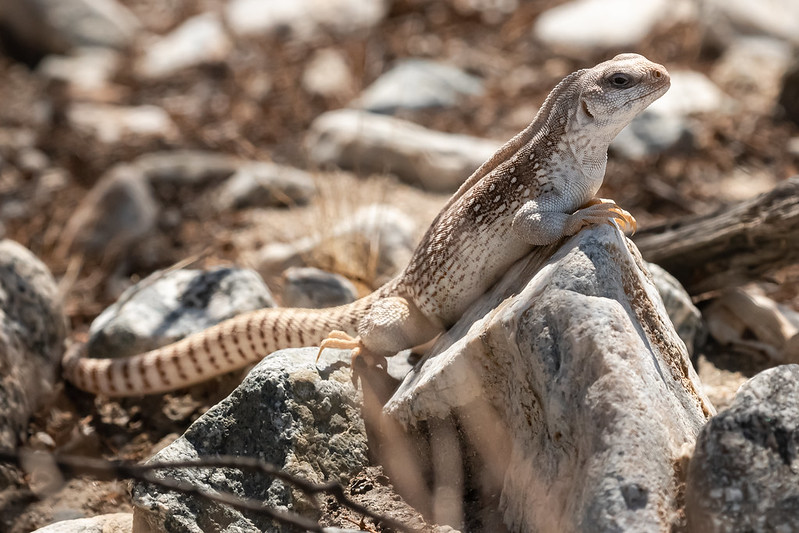
Desert Iguana
The desert iguana (Dipsosaurus dorsalis) is a lizard commonly found in the southwestern United States and northern Mexico deserts. This small reptile has adapted to live in harsh, arid environments by utilizing its thick scales for protection against predators and sunburns. It typically ranges from 6-14 inches long with a flattened tail that helps it move quickly on sand.
Desert iguanas are herbivorous animals that feed primarily on plant material such as cactus pads or flowers. They occasionally supplement their diet with insect larvae and other invertebrates. These lizards have an interesting thermoregulatory behavior; during hot days, they bury themselves beneath the surface of the sand to avoid overheating, while at night, they emerge to bask in the cool air temperatures.
Additionally, desert iguanas are solitary creatures who prefer to inhabit areas where vegetation is sparse but adequate for them to survive. During mating season, males become territorial over potential breeding sites and aggressively defend their chosen area from competitors. They reach sexual maturity between two to three years old and lay clutches of up to 16 eggs per year, which hatch after about 2 months incubation period.
In summary, the desert iguana is an adaptable lizard common throughout certain parts of North America. It utilizes several behavioral strategies like burrowing into the ground during hot days for temperature regulation and aggressive defense of breeding sites during mating season to survive in hostile conditions.
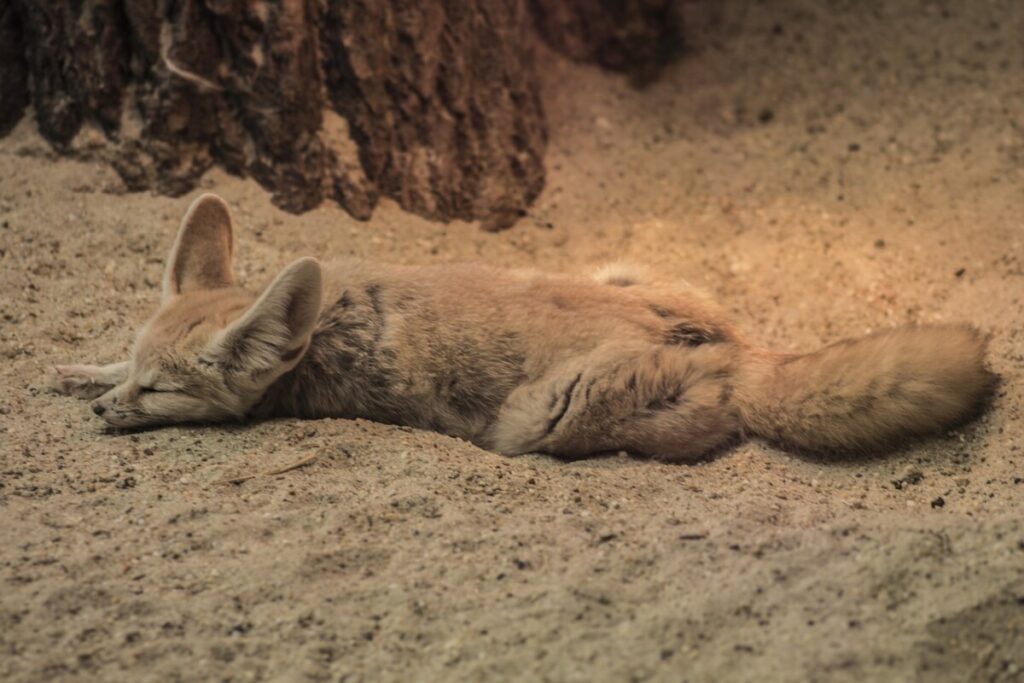
Fennec Fox
The fennec fox is a species of the Vulpes genus and inhabits the sandy deserts of North Africa, the Sinai Peninsula, and Arabia. It has large ears adapted to regulate its body temperature in hot climates and help it locate prey. The size of this omnivorous animal ranges from 24-41 cm (9.4-16.1 inches) with an average weight of 1-2 kg (2.2-4.4 lbs). Its coat is typically pale cream or yellowish-white with black tips on the tail and feet and varying amounts of dark guard hairs over the back and sides.
Fennec foxes have several adaptations that enable them to survive in arid environments. These include their ability to extract moisture from food, efficient thermoregulation mechanisms, wide distribution range, nocturnal habitation, and excellent hearing abilities. They mostly feed on small rodents but consume insects, eggs, birds, lizards, fruits, roots, and plants for supplemental nutrition when other resources are scarce.
These animals live in burrows where they can retreat during harsh weather conditions or rest during heat waves; however, they do not hibernate like other desert inhabitants due to their lighter fur coats. In addition to providing shelter from predators, these dens also offer protection against extreme temperatures by trapping warm air beneath the surface while allowing ventilation through ground-level cracks.
Due to their friendly nature towards humans, these animals have become popular exotic pets. However, there are potential drawbacks associated with owning one, including high expenses related to housing costs and specialized care requirements, as well as potential behavioral problems if socialization does not occur early enough. Despite being classified as the least concern on the IUCN Red List, conservation efforts should be considered since human intervention has disrupted traditional habitats leading to decreased population numbers in some areas worldwide.
Conclusion
When considering animals that inhabit the desert, it is important to consider various factors, such as their ability to adapt to extreme temperatures and lack of water. Many species have developed special skills to survive in the harsh climates found in deserts around the world. The top 10 animals discussed included the Mojave Desert Tortoise, Deathstalker Scorpion, Desert Iguana, Fennec Fox, and Greater Flamingo.
Each animal has unique traits which enable them to survive in a dry environment. For example, some animals can store water or regulate their body temperature more efficiently than other organisms living in different habitats. Additionally, they may require specific food sources or nesting areas depending on their conditions. These adaptations make life possible in an otherwise inhospitable environment.
The diversity of species that inhabit arid regions demonstrates how resilient nature can be when faced with challenging environments like those found within a desert biome. While not every creature can thrive under these circumstances, certain ones have established impressive strategies which allow them to live even in seemingly hostile settings. As research continues regarding these animals’ abilities to survive and thrive despite difficult conditions, we will continue to learn about their remarkable versatility and strength.

